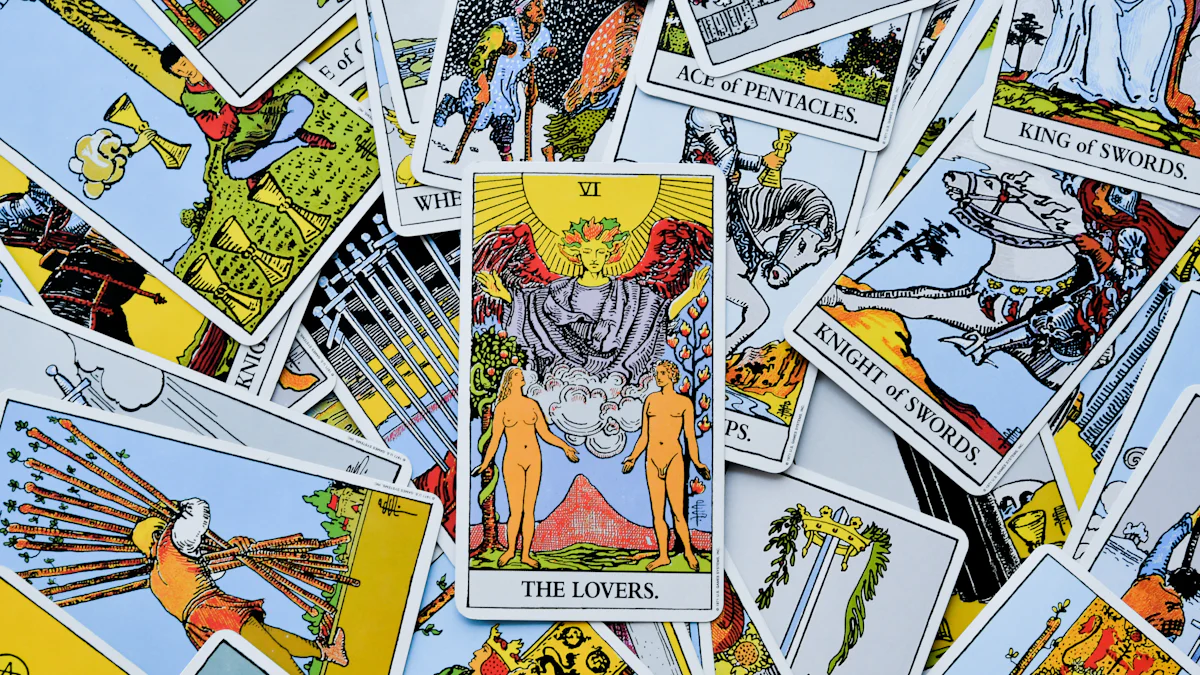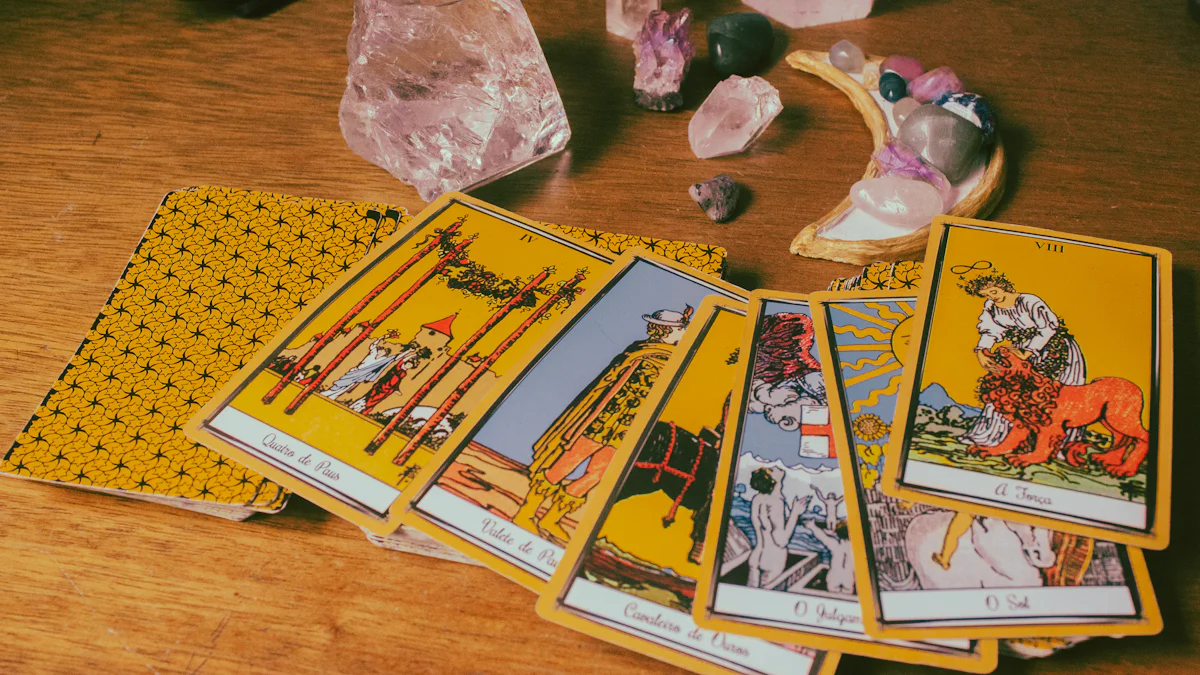
The Ace of Cups symbolizes emotional and spiritual abundance, offering a profound message of love and fulfillment. You may notice its imagery often emphasizes overflowing water, representing the boundless flow of emotions and intuition. Across tarot traditions like Rider-Waite, Thoth, and Marseille, this card consistently highlights themes of emotional growth and personal development. Its enduring appeal lies in its ability to inspire you to embrace love, nurture your intuition, and seek spiritual renewal. Whether you explore the Ace of Cups or the queen of cups as feelings, these cards encourage deeper connections with yourself and others.
Key Takeaways
The Ace of Cups shows strong feelings and fresh spiritual energy. It tells you to welcome love and trust your feelings.
Long ago, the Ace of Cups was linked to Egyptian ideas. It shows its deep meaning in many tarot traditions.
The pictures on the card, like the full cup and dove, show help from above and new emotional moments.
Today, the Ace of Cups means being open to feelings and building happy relationships. It helps you grow as a person.
The card’s changing meanings make it important now. It focuses on loving yourself, clear emotions, and accepting everyone.
Historical Origins of the Ace of Cups

Early Appearances in Tarot Decks
The Ace of Cups has a fascinating history that dates back to some of the earliest tarot decks. You can trace its origins to Egyptian influences, which are particularly evident in the Spanish Tarot. Early decks like the Alessandro Viassone tarot, a double-headed Italian design, included the Ace of Cups as a key card. Before the 20th century, Spanish-designed tarot decks did not exist. Instead, they borrowed heavily from Italian designs, showcasing the interconnectedness of tarot traditions across regions.
Influence of Key Figures and Texts
The depiction of the Ace of Cups owes much to historical figures and their writings. Éliphas Lévi, a prominent occultist, linked the card to its Egyptian roots. His work emphasized the mystical and symbolic aspects of tarot. Samuel Liddell MacGregor Mathers, another influential figure, expanded on this connection. He noted, “The Ace of Cups is of Egyptian origin, which can be more easily seen in the Spanish Tarot.” These insights shaped how you understand the card today, highlighting its deep spiritual and historical significance.
Evolution Through Cultural and Spiritual Contexts
The Ace of Cups has evolved significantly since its 15th-century origins, where it was known as “Il Coppe” in Italian Tarocchini games. Initially, its design featured a simple chalice. Over time, this imagery transformed into the intricate depictions you see in modern decks like Rider-Waite, where the card symbolizes divine intervention and spiritual awakening.
This evolution reflects changing societal values. During the Renaissance, the Ace of Cups began to embody emotional depth and human psychology. In the Thoth Tarot, it represents the root of water’s powers, symbolizing love and abundance. The Tarot de Marseille focuses on emotional and spiritual growth, viewing the card as a sign of intuitive maturity. Modern decks have further diversified its meaning, incorporating themes like nature and LGBTQ+ inclusivity. These changes ensure the Ace of Cups remains relevant across cultures and spiritual practices.
Symbolism of the Ace of Cups

Core Imagery and Interpretations
The ace of cups carries rich symbolism that resonates deeply in tarot readings. Its imagery often includes a hand emerging from the clouds, holding a cup overflowing with water. This hand represents divine intervention, suggesting that emotional or spiritual experiences may come unexpectedly into your life. The overflowing water symbolizes abundance, fulfillment, and the boundless flow of emotions.
You may also notice five streams flowing from the cup. These streams represent the five senses, emphasizing heightened awareness and perception. The dove, often depicted descending into the cup, signifies peace and purity, hinting at the arrival of love or a new relationship. The lotus flowers floating on the water symbolize spiritual growth and the unfolding of your potential. Together, these elements create a powerful message of emotional renewal and spiritual awakening.
The Inverted M and Its Mystical Significance
One of the most intriguing aspects of the ace of cups is the inverted M symbol often found on the cup itself. This symbol connects to themes of creation, mystery, and feminine energy. Mystical traditions link it to the waters of creation described in Genesis, representing the power that receives and transforms. Some interpretations also associate it with Egyptian motifs, such as twin serpents, further deepening its esoteric significance.
MacGregor Mathers, a key figure in tarot history, described the inverted M as a representation of the waters of creation. For you, this symbol may serve as a reminder of the creative and transformative power within emotional and spiritual experiences.
Emotional and Spiritual Themes in Tarot
The ace of cups embodies themes of emotional beginnings, love, and spiritual enlightenment. Its overflowing water reflects emotional abundance and intuition, encouraging you to embrace new emotional experiences. The hand emerging from the clouds highlights divine guidance, reminding you that spiritual growth often comes with external support. This card invites you to explore self-love, foster harmonious relationships, and embark on a journey of emotional renewal.
Variations of the Ace of Cups Across Tarot Decks
Classic Decks: Rider-Waite-Smith vs. Tarot de Marseille
The Ace of Cups appears differently in the Rider-Waite-Smith and Tarot de Marseille decks, reflecting their unique artistic and symbolic traditions. In the Rider-Waite-Smith deck, the card portrays a hand emerging from the clouds, holding a cup that overflows with water. This imagery emphasizes divine intervention and the act of giving. The cup itself is an allegory of the Holy Grail, symbolizing spiritual fulfillment and the life-giving blood of Christ. A dove descending into the cup represents the Holy Spirit, reinforcing themes of divine love and peace.
In contrast, the Tarot de Marseille deck presents a chalice with a castle-shaped lid, focusing on emotional and spiritual dimensions. This design lacks the hand motif, shifting the emphasis to the card’s connection with earlier Italian tarot traditions. The hexagonal shape of the cup symbolizes the union of the spiritual and physical worlds. These differences highlight how each deck interprets the ace of cups through its cultural and historical lens.
Modern Artistic and Cultural Interpretations
Modern tarot decks often reimagine the ace of cups to reflect contemporary values and artistic styles. Many artists incorporate diverse cultural symbols, such as lotus flowers or mandalas, to emphasize spiritual growth and emotional renewal. Some decks celebrate inclusivity by featuring LGBTQ+ themes or multicultural imagery, making the card more relatable to a broader audience.
Digital art has also transformed the way you experience tarot. Many modern decks use vibrant colors and intricate designs to create a more immersive experience. These artistic innovations ensure the ace of cups remains a timeless symbol of love and intuition while adapting to the evolving needs of tarot readers.
Regional and Spiritual Adaptations
The ace of cups has inspired regional and spiritual adaptations that enrich its meaning. In the Thoth Tarot, the card represents the root of the powers of water, symbolizing love, fertility, and emotional abundance. The Tarot de Marseille emphasizes emotional and spiritual dimensions, focusing on personal growth rather than romantic love.
Some regional decks draw inspiration from medieval motifs. For example, the Marseille deck uses a hand emerging from a cloud to signify divine gifts. Others, like the Waite-Smith deck, depict the cup as the Holy Grail, blending Christian symbolism with universal themes of renewal. These adaptations demonstrate how the ace of cups resonates across cultures and spiritual practices, offering you a versatile tool for self-discovery.
The Ace of Cups in Modern Tarot Readings
Common Interpretations: Upright and Reversed
When you draw the ace of cups upright in a tarot reading, it often signals emotional openness and joy. This card encourages you to embrace new emotional beginnings, whether through self-love or forming close connections. It also represents emotional fulfillment, suggesting that happiness and satisfaction are within reach. The table below highlights some common upright interpretations:
Interpretation | Description |
|---|---|
Emotional Openness | A positive sign of emotional openness and joy. |
New Connections | Signals readiness to forge new connections. |
Self-Love | Reminder to cultivate self-love and spiritual growth. |
Suggests the blossoming of a new romantic relationship filled with love. | |
Emotional Fulfillment | Indicates the potential for emotional fulfillment and bliss. |
In contrast, the reversed ace of cups may indicate emotional withdrawal or unfulfilled needs. You might experience challenges in expressing love or face miscommunication in relationships. This reversal serves as a reminder to address emotional blockages and reconnect with your inner self.
Applications in Love, Intuition, and Spiritual Growth
The ace of cups plays a vital role in love and relationship readings. It reflects your current emotional state and encourages you to nurture healthy relationships. This card often signifies the start of a new romantic relationship filled with mutual love and emotional depth. For existing relationships, it highlights emotional fulfillment and bliss. However, when reversed, it may point to unresolved emotional issues or difficulties in communication.
Beyond love, this card fosters intuition and spiritual growth. It symbolizes emotional renewal and unconditional love, urging you to embrace new emotional experiences. By doing so, you can enhance your emotional clarity and strengthen your connection to intuition. The ace of cups also acts as a beacon for self-awareness, helping you explore your inner world and grow spiritually.
Why the Ace of Cups Remains Relevant Today
The ace of cups continues to resonate with modern audiences because of its universal themes. It represents emotional well-being, self-love, and new beginnings in love and relationships. This card encourages you to embark on a journey of personal growth and introspection. Whether you seek emotional clarity, spiritual awakening, or deeper connections, the ace of cups offers timeless guidance. Its ability to adapt to diverse cultural and spiritual contexts ensures its enduring relevance in tarot readings today.
The Ace of Cups holds a timeless place in tarot, blending rich history with profound symbolism. Its imagery, from the overflowing cup to the dove and lotus, reflects emotional abundance, spiritual awakening, and the unraveling of your potential. This card invites you to embrace love, intuition, and renewal, offering guidance for personal growth and harmonious connections. In modern spirituality, it remains a beacon of emotional clarity and fulfillment. Whether you seek healing or new beginnings, the Ace of Cups continues to inspire, reminding you of the transformative power of love and self-discovery.
FAQ
What does the Ace of Cups symbolize in tarot readings?
The Ace of Cups symbolizes emotional abundance, love, and spiritual renewal. It encourages you to embrace new emotional experiences and deepen your intuition. This card often signals the start of fulfilling relationships or personal growth.
How does the Ace of Cups connect to Egyptian influences?
The Ace of Cups reflects Egyptian symbolism through its connection to creation and transformation. Historical figures like Éliphas Lévi linked the card to Egyptian motifs, emphasizing its mystical and spiritual roots.
What does the reversed Ace of Cups mean?
A reversed Ace of Cups suggests emotional blockages or unfulfilled needs. It may indicate challenges in expressing emotions or difficulties in relationships. This reversal encourages you to address inner struggles and reconnect with your feelings.
Why is the Ace of Cups important in love readings?
The Ace of Cups highlights emotional openness and new beginnings in love. It often signifies the start of a meaningful relationship or emotional fulfillment in existing ones. This card reminds you to nurture love and harmony in your connections.
How has the Ace of Cups evolved over time?
The Ace of Cups has evolved from simple chalice designs in early decks to intricate imagery in modern tarot. Its symbolism has expanded to include themes of divine love, emotional growth, and inclusivity, ensuring its relevance across cultures and spiritual practices.


